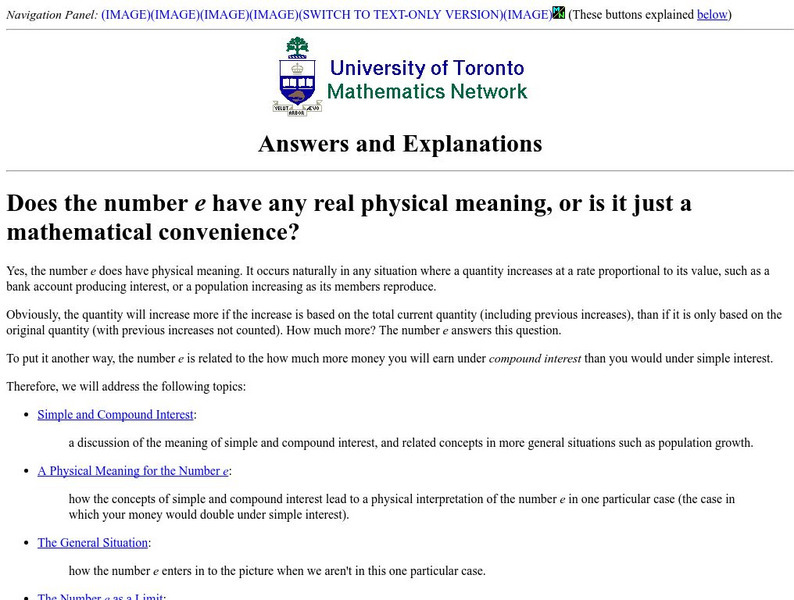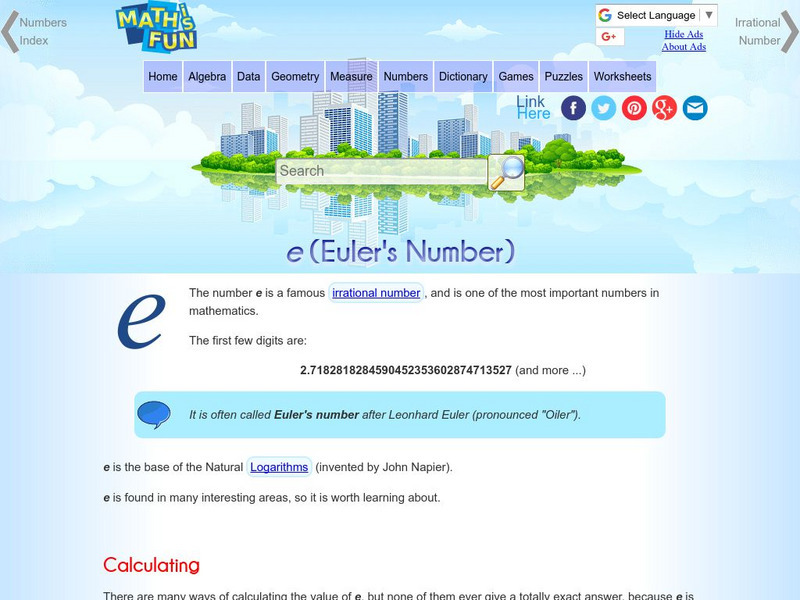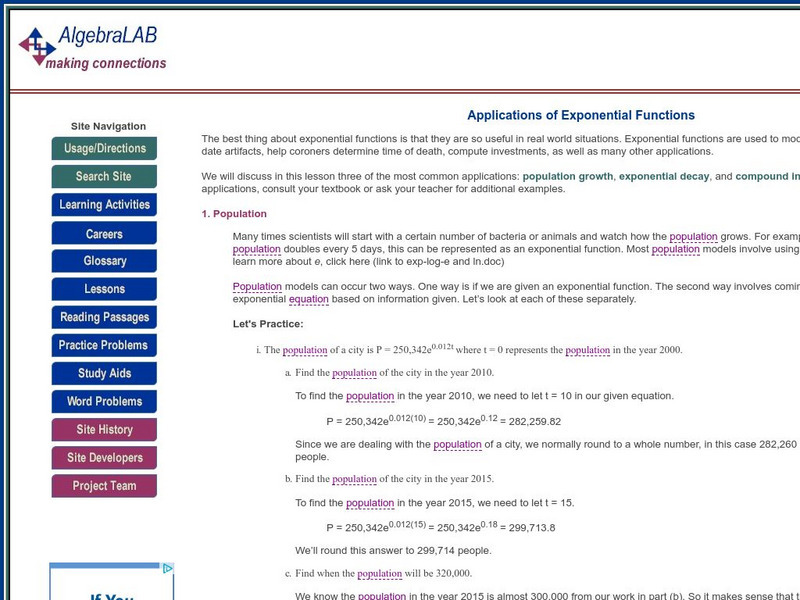Other
Especial Gas Inc.: Sulfur Properties and Compounds
This page from Especial Gas Inc. contains some very interesting information about the element sulfur, and some of its common compounds. The history and relative abudance of the element is discussed, as well as where it can be found. The...
Math Notes and Math Tests
Pre Calculus Notes: Exponential Functions and Their Graphs [Pdf]
Students explore exponential functions and their graphs. Exponential decay, the natural exponential function, and compound interest are examined. Proofs, explanations, and examples are included.
Purple Math
Purplemath: Exponential Functions: Introduction
Purplemath offers tables and graphs of various exponential functions for an exploration of how exponential functions behave from the real number domain. Compound interest problems are examined and the natural exponential is discussed...
PBS
Pbs: How Your Money Grows
Investigate how your money can grow on its own through compound interest.
Calculator Soup
Calculator Soup: Loan Calculator
Use this loan calculator to determine your monthly payment, interest rate, number of months or principal amount on a loan. Find your ideal payment by changing loan amount, interest rate and term and seeing the effect on payment amount.
Texas Instruments
Texas Instruments: Numb3 Rs: Financial Futures
Based off of the hit television show NUMB3RS, this activity shows students how money invested at different interest rates grow differently. The lesson focuses on aspects of interest such as compounding, length of time between...
Illustrative Mathematics
Illustrative Mathematics: A Sse the Bank Account
For this task, students are asked to interpret equations representing a bank account's balance where the interest is compounded monthly versus yearly. Aligns with A-SSE.A.1 and A-SSE.A.1.a.
University of Toronto (Canada)
U. Of Toronto: Does the Number E Have Real Physical Meaning?
This site explains why the number e does have meaning outside of its purely mathematical applications. Gives an example of this using compound interest. Also explains the number e as a limit and its role in calculus.
Other
Critical Thinking Community: Remodeling Lessons for High School
Learn to re-model your lesson plans to include room for critical thought and higher levels of learning. Re-modeled lessons cite specific critical thinking strategies. Wonderful examples include "Vitalizing Vapid Vocabulary," "To Kill A...
Thinkport Education
Maryland Public Television: Sense and Dollars
Engaging, fun tutorials and interactive games related to earning, spending, saving, and budgeting money.
Richland Community College
Richland Community College: Geometric Sequences
Richland Community College provides a lesson on geometric sequences. This site has explanations and examples of their properties.
Council for Economic Education
Econ Ed Link: A Penny Saved
Students will read the comic book, "A Penny Saved" published by the New York Federal Reserve Bank. Students will make the information relevant through projects, graphic organizers, teacher instruction, and problems.
ClassFlow
Class Flow: Checking and Savings Accounts
[Free Registration/Login Required] Practical Mathematics begins with the basic checking and savings account and how to reconcile a checking account statement. Simple and compound interest are demonstrated in this step by step flipchart.
Math Is Fun
Math Is Fun: E (Euler's Number)
Explains what Euler's Number is, its significance, and the formula used to calculate this irrational number. Gives memory tricks for remembering the value of e to 10 or 15 decimal places. Looks at some interesting properties of e and how...
Khan Academy
Khan: Lsn 8: Interpreting Relationships in Scatterplots/graphs/tables/equations
This instructional activity focuses on Interpreting and analyzing linear, quadratic, and exponential models and graphs. Students will use best fit lines to interpret contexts, distinguish whether contexts are linear or exponential...
Other
Algebra Lab: Applications of Exponential Functions
Explains how exponential functions have applications in real-world scenarios, including a population of a city, the growth of bacteria, drug decay, and compounding interest. Includes four word problems to try, with hints and answers...
Consumer Financial Protection Bureau
Consumer Financial Protection Bureau: Saving for Post Secondary Education
Young scholars use an online compound interest calculator to answer questions and create charts that show the value of saving money over time for future education goals.
CK-12 Foundation
Ck 12: Algebra Ii: 3.9 the Transcendental Number E and Natural Log
This section introduces the transcendental number e which is a special number that is considered a natural base. In addition to exploring how to simplify and solve equations with e, this section also investigates how it can be used to...
Annenberg Foundation
Annenberg Learner: Math in Daily Life: Savings and Credit
A brief article explaining the basics about savings accounts and two kinds of interest: simple and compound. Also learn about managing your credit and credit card debt. Click on "Know the Terms: How to Manage Your Credit Cards" to read...
Calculator Soup
Calculator Soup: Rule of 72 Calculator
Use the Rule of 72 to estimate how long it will take to double an investment at a given interest rate. Divide 72 by the interest rate to see how long it will take to double your money on an investment.
University of Nebraska Omaha
University of Omaha: Why We Save [Pdf]
Why do people need to save money? This lesson plan is geared for Kindergarten through 2nd grade and helps students understand the reasons for saving.
Yale University
Solving Problems by the Hundreds
This site contains a study of percentage and its applications in the study of consumer related problems. Problems involving sales tax are included. Examples, explanation, solutions and a bibliography are also included in the site.
Other
Sierra College: Elementary Algebra Review Sheet and Common Formulas
This review sheet includes important rules, properties, formulas, and equations needed to solve many Algebra problems.
Texas A&M University
Wtamu Virtual Math Lab: Intermediate Algebra
This site is a tutorial for students in algebra 2 or for those who need a refresher. The site has explanations, definitions, examples, practice problems and practice tests are found covering topics such as linear equations, graphing,...
Other popular searches
- Simple and Compound Interest
- Simple Compound Interest
- Compound Interest Projects
- Compound Interest Recursion
- Compound Interest Worksheets
- Money Compound Interest
- Sinple and Compound Interest
- Compound Interest Retirement
- Interest Compound
- Money + Compound Interest
- Compound Interest Formulas
- Compound Interest/worksheet

![Pre Calculus Notes: Exponential Functions and Their Graphs [Pdf] Unknown Type Pre Calculus Notes: Exponential Functions and Their Graphs [Pdf] Unknown Type](https://static.lp.lexp.cloud/images/attachment_defaults/resource/large/FPO-knovation.png)













